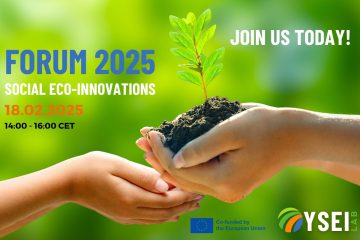Building joint projects empowers young people to actively engage in social eco-innovations. By promoting collaboration, these projects foster creativity, leadership, and ownership among youth workers and young people alike. This document will provide guidance on how to effectively create joint projects that support the implementation of youth-led social eco-innovations.

As a framework for this joint projects it is recommendable to foster youth-led decision making principles. Youth-led decision-making methods empower young people to have a voice, contribute their opinions, and actively participate in creating positive change in their communities. Some aspects of these frameworks:
• Empower young people to take ownership of the project from the beginning by involving them in decision-making processes.
• Implement participatory methods from consensus-building activities to participatory budgeting to ensure inclusivity and equal representation.
• Provide mini trainings on leadership and decision-making skills or highlight this methods during the cooperation (learning by doing) to enhance the ability of young people to facilitate collaborative decision-making processes for their own groups.
The content below highlights key focal points and provides examples and tools available in the EU in the interest of build joint projects.
1. Establish a Common Vision
• Clearly define the purpose & shared objectives related to the desired outcomes for the joint project.
• Encourage open dialogue and active participation from young people in the decision-making process.
• Use visual communication tools, such as mood boards or mind maps, to facilitate the understanding and alignment of the project vision.
• Consider the alignment with the Sustainable Development Goals (SDGs) as a framework for addressing global challenges.
Source: UN Sustainable Development Goals – https://sdgs.un.org/goals
2. Encourage Collaboration and Partnerships & Identify Stakeholders
• Promote cooperation and partnerships among organizations, institutions, and local communities, throughout also an interdisciplinary approach.
• Ensure the involvement of relevant stakeholders, such as local communities, NGOs, and businesses, to promote diverse perspectives and resources.
• Use tools like stakeholder analysis or impact mapping to identify potential partners and their roles in the project.
• Leverage existing networks and platforms, such as the European Youth Portal, to connect with potential stakeholders: www.europeanyouth.eu

3. Ensure and Facilitate Sustainable Project Management:
• Establish clear roles and responsibilities for each participant, ensuring everyone understands their contribution to the project.
• Develop a project management plan that outlines key activities, timelines, and the responsibilities.
• Find project management tools supporting yourself to develop your innovative project, such as https://www.salto-youth.net/tools/toolbox/tool/training-kit-on-project-management-t-kit-series.68/
• Concern utilising simple online project management tools to enhance young people’s project coordination skills on a way that are attractive to this generation. Some opportunities you can find here: Asana, Wrike, KanbanFlow, Trello, Teamwork, ClickUp.
4. Resource Mobilisation:
• Identify and allocate resources required for the successful implementation of the project.
• Explore funding opportunities, grants, and sponsorships specific to joint projects.
• Promote innovative and sustainable ways to mobilise sources to show a vision that can also serve as a reference in the future to mobilise resources, such as crowdfunding or partnerships with the private sector. An opportunity for this: European Youth Foundation – https://www.coe.int/en/web/european-youth-foundation
5. Monitor and Evaluate Project Impact:
• Establish a monitoring and evaluation framework, set up monitoring tools to track progress and measure the impact and outcomes of the joint project.
• Collect feedback from young people and co-workers, and other stakeholders to assess the project’s effectiveness and identify areas for improvement.
• Regularly collect data, analyse results, and share feedback among partners.
• Identify lessons learned and make necessary adjustments to ensure project success.
(Sources you can find among others in the above mentioned Salto ToolKit)
6. Celebrate Achievements and Highlight Youth Innovations:
• Provide opportunities for sharing their projects and experiences at national or international forums to inspire and motivate other young people.
• Recognise and celebrate the achievements of young people and their innovations through awards, exhibitions, or local events.
Building joint projects is a vital step in supporting youth-led social eco-innovations. By following the focal points highlighted above, youth workers and young people can effectively create impactful and sustainable projects. The suggested bullet points, accompanied by the provided examples and tools, offer practical support and inspiration for implementing joint projects throughout the European Union.
ENJOY!


